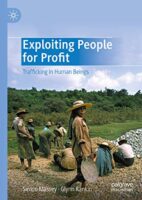Last Updated on August 9, 2021 by themigrationnews

In their book Exploiting People for Profit: Trafficking in Human Beings, Simon Massey and Glynn Rankin provides a contemporary definition of human trafficking. Both authors are quite well-versed in the field of human trafficking. Massey, previously a consultant for the EU and UNDP, and now a senior lecturer at Coventry University, is profusely published in the field of migration and criminal networks. While Rankin has worked as a prosecutor for over 20 years gaining invaluable expertise in cases of human trafficking. in addition, he is also the co-founder of the UK Human Trafficking Center. The authors fully investigate the process of human trafficking, its criminality, and ways of preventing it. The book is well organized and divided into five main chapters, each with subsequent headings and a conclusion. The authors define human trafficking as a violation of human rights and the “third-largest criminal enterprise in the world after the illegal sale of drugs and arms” (2020: 10). The definition is derived from the UN Convention against Transnational Organized Crime (UNTOC). While most academics believe that human trafficking “is committed within established models of transnational organized crime” (2020: 2) the authors emphasize that it varies and is actually much harder to define. Human trafficking could occur in many different criminal models both within state borders and transnationally and can also sometimes include licit activities. The authors describe that human trafficking derives its meaning from international law and that it was relatively newly defined (the year 2000) which causes debate on whether it is a new concept or not. The authors, using various statistics, explain that the issue is very relevant and pressing in our contemporary world (2020: 9), however, its international dimension makes it hard to prosecute, due to limiting jurisdictions.
The first chapter contextualizes human trafficking explaining that the phenomenon is caused by “a variety of cultural and economic drivers” (2020, 1) and the criminality of it varies in different cases such as removal of organs for transplant, sexual enslavement, etc. The chapter is divided into 4 subcategories that explain the causal factors that lead to human trafficking, the seriousness of the threat of human trafficking, the boundaries of the definition of human trafficking, and the difference between modern slavery and human trafficking. To begin with, the authors discuss some of the factors that lead to trafficking which include societal factors such as patriarchal structures, gender discrimination, poor education. Economic factors including disparities in wealth and lack of employment. The research reveals that there is a correlation to migration issues since restricting immigration can facilitate it (2020: 5). They explain that while accurate statistics are hard to find, the numbers show a growth in both prosecutions and convictions of human trafficking with the largest numbers originating from the UK, Albania, and Vietnam (2020: 9). However, it is mentioned that the number of prosecutions is not reflective of the “rising estimates of human trafficking in all regions of the world” which may be due to the difficulty of investigating such multidimensional crimes (2020: 9). They point out the shortcoming of available definitions due to insufficient domestic legislation and case law for clarification. Even with a common understanding of the concept “in practice, there remain differences in criminal justice and law enforcement approaches” (2020: 29).
In the first chapter, the authors also explore the relation of trafficking to ‘modern slavery’, explaining that it is not just a historic issue but also a contemporary one. In fact, in 2013 the first edition of the Global Slavery Index was published (2020: 25). However, the authors also discuss some of the criticism towards the concept as it is regarded as a western-centric interpretation. They explain that the United Kingdom moved from focusing on individual crimes of exploitation to the overarching concept of modern slavery crimes. And the authors warn that other countries following suit may lead to “further dilution of human trafficking as a stand-alone offense” (2020: 29).
In the second chapter “Agency, Consent, and Exploitation”, the authors emphasize the distinction between human trafficking and people smuggling; smuggling involves people active in a crime while human trafficking involves victims. They also explain the indicators used by states to identify migrants as either trafficked or smuggled which affect the prosecution of cases. “The purpose of human trafficking is the exploitation of the victim” (2020: 46) but since each state is expected to provide its own definition of exploitation the distinction becomes problematic. Thus, they infer that more research and more practical practice is necessary to provide clearer distinctions between smuggling and trafficking.
In chapter three titled “Pursuing Human Traffickers”, Massey and Rankin discuss the factors that impede a successful prosecution of human trafficking cases. They mention that all victims of trafficking “are entitled to the following standards: respect for their human rights, protection and safety, individualized care, the right to self-determination, full information and consent, the right to non-discrimination, and confidentiality” (2020: 55). A good prosecution means less organized crime; thus, it is essential. However, the issue is the costliness. The most successful prosecutions are proactive ones that place the victims at the center of the investigation and employ sensitive case management. They also discuss the effect of Brexit on the prosecution process since the UK “will no longer accept the jurisdiction of the Court of Justice of the European Union (CJEU)” (2020: 70). Thus, Brexit is believed to present a setback in “the construction of a holistic response to the pursuit of traffickers” within the United Kingdom and European Union (2020: 74).
In the fourth chapter, the importance of protecting victims of human trafficking is highlighted as they have already experienced physical and psychological damage. Since “non-punishment provisions in the international law are not uniformly understood or consistently applied” (2020: 79) they propose that there should be national mechanisms of protecting victims of trafficking. In the chapter, they discussed the rights of victims within the investigation and prosecution processes and methods of victim protection. They also discuss the National Referral Mechanisms (NRM) which is defined as “a co-operative framework so you allow states to identify, protect, and promote the human rights of Catholic persons in coordination with civil society” (2020: 94). They infer that protection is especially important because it encourages more victim testimonies.
Finally, in the fifth chapter “Preventing Human Trafficking”, Massey and Rankin discuss strategies for pre-emptive prevention of trafficking, including raising awareness through education and campaigns. They refer to case studies to assess “the scope of anti-trafficking knowledge dissemination” (2020: 102), emphasizing that efforts of prevention should be evidence-based, and monitored to evaluate their effectiveness. Authors inferred that the collection of accurate data is important both in affecting evidence-based policy formulation “as well as macro foreign policy and development strategies to mitigate push factors in the countries of origin” (2020: 117). Authors mentioned that in order to achieve an effective counter-trafficking strategy, there should be a unanimity of purpose, which should include “a common interpretation of international law as it applies to human trafficking, notably the Trafficking Protocol, translated, if necessary, into corresponding national legislation” (2020: 122). The study also investigated the 4 “Ps’ counter-trafficking framework – pursuit, protection, prevention and partnership” (2020: 123) evaluating the successes and failures in which the elements have been put into effect. It insinuates that the Trafficking Protocol is essential but its translation into law has resulted in “inconsistent interpretations of the definition of human trafficking and have sometimes undermined collaboration between jurisdictions” (2020: 124).
Overall, Massey and Rankin have done a good job in introducing the concept of human trafficking to the readers and showcasing that it is indeed a pressing contemporary issue. They have presented well-organized, easy-to-read, well-referenced chapters explaining societal and economic issues that lead to human trafficking, its criminality, the difficulties and requirements of proper prosecution, and methods of preventing trafficking. Each chapter is equipped with its own abstract and conclusion which is helpful in summing up the most important points within each chapter. In addition, there is a concluding chapter that summarizes the study and ties points made in different chapters to one another creating a wholesome argument, thereby ensuring the reader’s understanding. The authors also mentioned suggestions for how their research may be improved as well as good improvement suggestions for international lawmakers and prosecutors of human trafficking cases. Thus, overall, the book is very informative, not just to researchers of the issue but also to the layman due to the diction decisions which is essential in a study dedicated to such a pressing humanitarian issue.
Overall, the book is both a great introduction to human trafficking to those without any background knowledge on the issue, as well as an excellent source of information for researchers of human trafficking. Massey and Rankin did a remarkable job in introducing key concepts related to trafficking, its criminality, prosecution, and methods of combating it. The only drawback is repetitiveness; though succinct conclusions are available at the end of each chapter, some of the points in the chapters are recurrent and could have been eliminated to provide an easier read.
Source: Massey, S. and Rankin, G., 2020. Exploiting People for Profit: Trafficking in Human Beings. 1st ed. London: Palgrave Macmillan.

Ranaa Madani, Editor at The Migration News, and Master’s Degree Graduate of Media and Development from SOAS University London. Email: ranaamadani1@gmail.com
